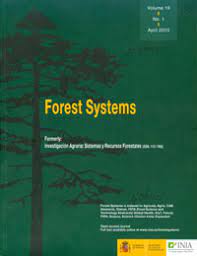Ver ítem
- xmlui.general.dspace_homeCentros Regionales y EEAsCentro Regional Buenos Aires NorteEEA Delta del ParanáArtículos científicosxmlui.ArtifactBrowser.ItemViewer.trail
- Inicio
- Centros Regionales y EEAs
- Centro Regional Buenos Aires Norte
- EEA Delta del Paraná
- Artículos científicos
- Ver ítem
Caracterización estacional de una plantación de Populus deltoides cv Catfish 2 en el bajo delta bonaerense del río Paraná (Argentina)
Resumen
El objetivo del trabajo consiste en identificar componentes del ambiente y de manejo determinantes de la diferente productividad de una plantación de Populus deltoides cv Catfish 2, de 2 hectáreas de superficie y 12 años de edad, en un área endicada del Bajo Delta Bonaerense del Río Paraná (Argentina). La producción de las Salicáceas en la región se estima en 20-25 m3/ha/año. Se hizo un inventario de la plantación y se subdividió en 199 parcelas de 96 m2
[ver mas...]
El objetivo del trabajo consiste en identificar componentes del ambiente y de manejo determinantes de la diferente productividad de una plantación de Populus deltoides cv Catfish 2, de 2 hectáreas de superficie y 12 años de edad, en un área endicada del Bajo Delta Bonaerense del Río Paraná (Argentina). La producción de las Salicáceas en la región se estima en 20-25 m3/ha/año. Se hizo un inventario de la plantación y se subdividió en 199 parcelas de 96 m2 c/u. En cada una de ellas se midieron las alturas del árbol dominante y las del promedio, las cotas de nivel del terreno, y se registraron todas las plantas quebradas por el viento a causa de Platypus mutatus Chapuis. En cada uno de los tres sectores definidos por la altura del terreno, se estudiaron 27 muestras de suelo. Los ambientes de albardón y semialbardón, protegidos por un dique perimetral, moderadamente bien drenados y profundos, de la familia textural franca-gruesa, presentaron incrementos maderables promedios superiores a los 30 m3/ha/año, y mayor pérdida de volumen comercial a causa del ataque de Platypus mutatus Chapuis, mientras que los de bañado endicado con capas sub-superficiales alcalino-sódicas y un pH ligeramente alcalino a 28 cm de profundidad, tuvieron incrementos de 28,5 m3/ha/año. En esta
plantación Carex riparia, Hydrocotyle bonariensis y Duchesnea indica se asocian a una buena calidad de estación, en cambio Rubus sp., Iris pseudacorus, Phalaris angusta y Bromus unioloides a una de menor calidad.
[Cerrar]
The objective of this work consists of the identification of the ambient and management components which determine different productivities in a 12 years old Populus deltoides cv Catfish 2 plantation. The plantation occupies a surface of 2 hectares in an area protected by a perimetrical dike of the low Delta of the Paraná River in the Province of Buenos Aires (Argentina). The Salicaceae average yield increment for this region was estimated in 20-25
[ver mas...]
The objective of this work consists of the identification of the ambient and management components which determine different productivities in a 12 years old Populus deltoides cv Catfish 2 plantation. The plantation occupies a surface of 2 hectares in an area protected by a perimetrical dike of the low Delta of the Paraná River in the Province of Buenos Aires (Argentina). The Salicaceae average yield increment for this region was estimated in 20-25 m3/ha/year. A plantation inventory was done and, later on, the whole set was subdivided into 199 plots of 96 m2 each. In each plot, the heights of the dominant and the average trees were measured, and also the land contour elevation readings, as well as, the number of broken plants by the wind because of the action of Platypus mutatus were registered. In each of three areas defined by the land elevation, 27 soil samples were analysed and studied. Those ambients defined as high lands or ridge of fertile land («albardón») and intermediate high lands or ridge of median fertile land (semi-albardón), protected by a perimetrical dike, moderate well drained and deep, pertaining to the franco-coarse textural family, presented wood yield average increments greater than 30 m3/ha/year, and also greater loss of commercial volume because of the Platypus mutatus attack , while those located in the low lands (bañado), protected by dike, with alkaline-sodium layers under surface and a slightly alkaline pH at a depth of 28 cm, showed an average increment of 28.5 m3/ha/year. In this commercial plantation, Carex riparia, Hydrocotyle bonariensis and Duchesnea indica are associated to good sites, but Rubus spp., Iris pseudacorus, Phalaris angusta and Bromus unioloides are associated to those sites of low quality.
[Cerrar]

Autor
Casaubon, Edgardo;
Gurini, Laura Beatriz;
Cueto, Gerardo Rubén;
Gomez, Luis Alberto;
Zanelli, Marta;
Berrondo, Maria Graciela;
Gonzalez, Adrian Claudio;
Fuente
Forest Systems 13 (2) : 369-385 (2004)
Fecha
2004
Editorial
Instituto Nacional de Investigación y Tecnología Agraria y Alimentaria (España)
ISSN
2171-9845
2171-5068
2171-5068
Formato
pdf
Tipo de documento
artículo
Palabras Claves
Derechos de acceso
Abierto
 Excepto donde se diga explicitamente, este item se publica bajo la siguiente descripción: Creative Commons Attribution-NonCommercial-ShareAlike 2.5 Unported (CC BY-NC-SA 2.5)
Excepto donde se diga explicitamente, este item se publica bajo la siguiente descripción: Creative Commons Attribution-NonCommercial-ShareAlike 2.5 Unported (CC BY-NC-SA 2.5)


